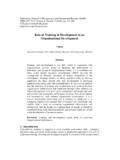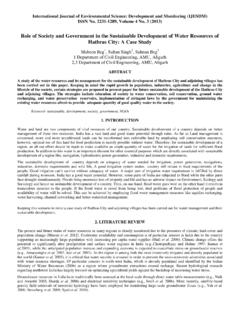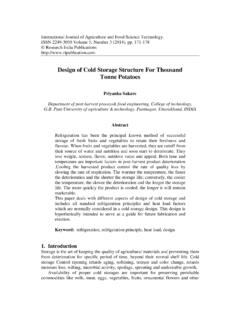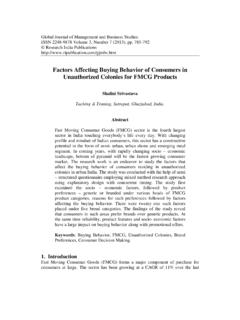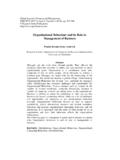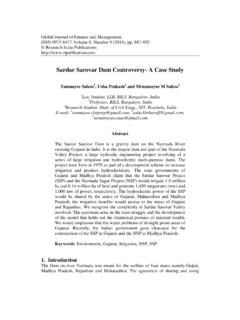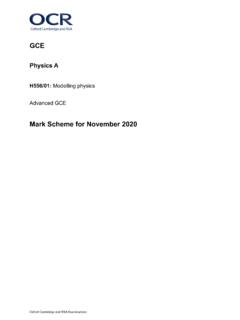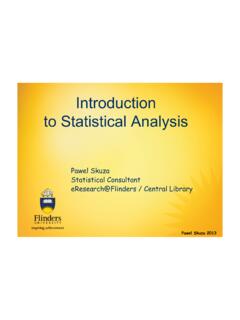Transcription of DETERMINATION OF PRESSURE COEFFICIENT AROUND NACA …
1 DETERMINATION OF PRESSURE COEFFICIENT AROUND NACA AIRFOIL Ashish P Kunjumon UG Student, Department of Mechanical Engineering, Mar Baselios Christian College of Engineering and technology Kuttikanam, Peermade Felix Mathew Koshy UG Student, Department of Mechanical Engineering, Mar Baselios Christian College of Engineering and technology Kuttikanam, Peermade Steevo Tom Jacob UG Student, Department of Mechanical Engineering, Mar Baselios Christian College of Engineering and technology Kuttikanam, Peermade Sunildutt Assistant Professor, Department of Mechanical Engineering, Mar Baselios Christian College of Engineering and technology Kuttikanam, Peermade. Abstract The aim of the present study is to emphasize mainly the parameters such as the distribution of PRESSURE and velocity over an airfoil surface.
2 The complete process of modelling and simulation of the airfoil at various angle of attacks is investigated. The project focus mainly on the simulation of the airflow AROUND the airfoil. The fluid flow simulations are obtained with ANSYS Fluent The pre-processing including the creation and modification of the surface mesh in ANSYS with two dimensional grid generation. The working fluid used is air. Incompressible inviscid flow, combinations of the angle of attack and inlet velocity are the various parameters. Keywords: Airfoil, Angle of Attack, Lift force, PRESSURE COEFFICIENT , Simulation Introduction Aerodynamics is a branch of science that deals with the analysis of flow over a body.
3 An airfoil is the shape of a wing or blade or sail as seen in cross-section. An airfoil-shaped body moved through a fluid produces an aerodynamic force. The component of this force perpendicular to the direction of motion is called lift. The component parallel to the direction of motion is called drag. An airfoil is a streamline body which has a rounded leading edge, is elongated and is given a gradual curvature in the flow direction. By using ANSYS, flow analysis becomes more effective as it investigates everything more thoroughly than experimental method. Computational fluid dynamics provides a qualitative and sometimes even quantitative prediction of fluid flow by means of mathematical modelling , numerical method and software tools.
4 CFD analysis enables an engineer to compute the flow numerically in a virtual flow laboratory . The analysis consists of several steps such as: problem statement, mathematical modelling , mesh generation, space discretization, time discretization, iterative solver, simulation run, post processing, and verification. ANSYS is vast computational software that enables researchers to analyse the problems related to different engineering sectors. It is used to solve problems related to heat transfer, fluid flow, turbulence, industrial machineries, explicit dynamics, and structural analysis with the assistance of numerical analysis. Narayan U Rathod [1] , carried out to emphasize mainly the parameters such as the distribution of PRESSURE is more in the lower part of the leading edge and distribution of velocity is more in the upper part of the leading edge.
5 Mayank Pawar et al.[2] ,study deals with the study of static PRESSURE distribution International Journal of Applied Engineering Research ISSN 0973-4562 Volume 14, Number 14, 2019 (Special Issue) Research India Publications. 81 of 87 over the surface of an aerofoil. Shivasharanayya Hiremath et al. [3] work presents the simulated flow over an aircraft and observed that the lift increases as angle of attack increases. MD. Safayet Hossain et al. [4] Work presents, flow analysis of two airfoils (NACA 6409 and NACA 4412) was investigated. Drag force, lift force as well as the overall PRESSURE distribution over the airfoils were also analyzed. N. Gregory et al. [5] Results are presented for the aerodynamic characteristics of NACA 0012 airfoil section at two different Reynolds numbers.
6 Airfoils and aerodynamic shaped objects are extensively used in all types of air vehicles for example space shuttle, aircrafts, helicopters, acrobatic aircrafts, and even in various types of missiles. Besides, when it comes to fluid machineries such as pump, turbine, windmill, the shape of impeller, propeller is very important. In this investigtaion, study about the flow characteristics AROUND symmetrical and cambered airfoil at zero angle of incidence was analyzed. The variation of PRESSURE difference on the upper and lower surface of an airfoil at the leading and trailing edge was determined and the velocity flow patterns AROUND the symmetrical and cambered airfoil at different angle of attack was also investigated Methodology Computational Fluid Dynamics (CFD) is a numerical method used to simulate physical problems with use of governing equations.
7 This method can be used to investigate design approaches without creating a physical model and can be a valuable tool to understand conceptual properties of new mechanical designs. By using a simulation instead of doing lab experiments, one may acquire results faster and with less expense. In this paper, NACA 0012 and NACA 2424, the well documented airfoils from the 4-digit series of NACA airfoils are utilized. The NACA 0012 airfoil is symmetrical, and NACA 2424 is cambered. Maximum thickness 12% at 30% chord. Maximum camber 0% at 0% chord for NACA 0012. Max thickness 24% at 30% chord. Max camber 2% at 40% chord for NACA 2424. Reynolds number for the simulations was Re = 3 105.
8 Following is the method employed to carry through the CFD simulation: 1 Preparing geometric model. 2 Generate meshing. 3 Setting boundary conditions. 4 Software (Fluent) setup, initialization Preparing geometric model The airfoil geometries was acquired as co-ordinate vertices texts file are imported into the ANSYS FLUENT. FLUENT is essential in the process of doing the CFD analysis, it creates the working environment where the object is simulated. An important part in this is creating the mesh surrounding the object. The mesh and edges must also be grouped in order to set the necessary boundary conditions effectively. Fig 1. Fig1. Physical domain of the problem Firstly, airfoil co-ordinates are imported and the curve is formed.
9 The 2D analysis type is used and launch the design model created. Then create the surface to the curve, then the airfoil is generated. Next step is to create a surface from this sketch. The final step of creating the C-Mesh is creating a surface between the boundary and the airfoil by using Boolean operations. In the final step of creating the geometry, the new surface is splitted into 4 quadrants and divided into 5 blocks. The geometry is finished. Save the project and close the design modeler. Create the mesh for the simulation. Fig 2. Dividing the C-Mesh into 5 blocks and 4 quadrants. International Journal of Applied Engineering Research ISSN 0973-4562 Volume 14, Number 14, 2019 (Special Issue) Research India Publications.
10 82 of 87 Generate Mesh An environment consisting of 2 squares and 1 semicircle surrounds the airfoil. For the airfoil a structured quadratic mesh is used with a fine mesh AROUND the airfoil. A fine mesh implies a higher number of calculations which in turn makes the simulation use longer time to finish. Grid convergence: Two different meshes are made to the CFD simulations. This is to test the grid convergence, how the change in number of cells, and hence also cell size, affect the result. Grid independence study is conducted by using successively smaller cell sizes. Fig 4. Mesh AROUND NACA 0012 airfoil Fig 5. Mesh AROUND NACA 2424 airfoil Setting Boundary Conditions Giving properties to the different geometries is vital to make the simulation work.
